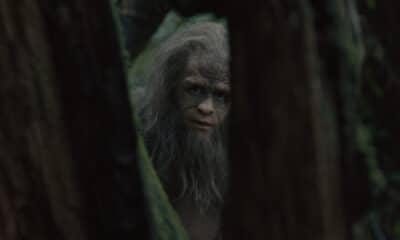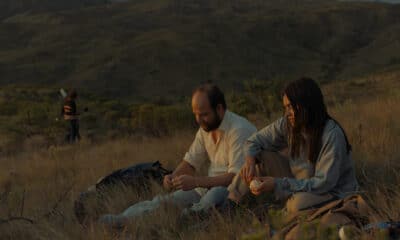As we march bravely on through 2013, THN will take a nostalgic yet critical look at the 53 Walt Disney Animated Classics, from SNOW WHITE to WRECK-IT RALPH, through the obscurity of FUN AND FANCY FREE to the Golden Age of BEAUTY AND THE BEAST. These are the films the Walt Disney company are most proud of, the ones that hold a special place in our hearts, the ones that still cost a fortune to buy on DVD. This time, THE FOX AND THE HOUND.
Directed by Ted Berman, Richard Rich and Art Stevens
1981/ 83 minutes
Based upon the original novel by Daniel Mannix, THE FOX AND THE HOUND began its life under the working title Tod and Copper.
The original novel had a more realistic and bleak story, following the quest of a hunter and his dog, Copper, to shoot Tod after he has killed the hunter’s new dog, Chief. The novel focussed on Tod’s life in the woods; while being raised by humans he was childhood friends with Copper and none of the animals spoke.
Continuing the trend, the Disney studio changed the story to make it more suitable for a family film; instead of a story about the life and death of a fox, it became a parable about how society determines our roles despite our better impulses.
Beginning production in 1977, THE FOX AND THE HOUND marked a turning point for the Disney Animation studios, and something of a changing of the guard.
Up until this point, each film in the “Disney 53” had been worked on by Walt Disney’s original team, the “Nine Old Men”, many of whom had gone on to produce later films. But here, a new generation of animators had arrived, bringing with them some friction between the two groups of animators, as the new kids on the block took up the baton to finish the film themselves, having come through the studio’s in-house training program. Producer (and director of umpteen Disney movies by this point), Wolfgang Reitherman, wanted the film to remain faithful to the book, and had his own ideas on how to run things, but the new team backed co-director Art Stevens (who had also worked on THE RESCUERS half a decade earlier).
In amongst this new generation of animators were many future household names;
- Tim Burton’ s personal style consistently clashed with Disney’s “house style”, but he would go on to direct one of Disney’s highest-grossing films, ALICE IN WONDERLAND (2010), as well as directing both BATMAN and BATMAN RETURNS. He also may or may be working on a new stop-motion version of THE ADDAMS FAMILY (according to cinemablend).
- John Lasseter would go on to become one of Pixar’s founding fathers and is currently Chief Creative Officer of both Pixar and Disney studios.
- John Musker and Ron Clements would become one of Disney’s most successful directing teams, directing THE GREAT MOUSE DETECTIVE (1986), THE LITTLE MERMAID (1989), ALADDIN (1992), HERCULES (1997), TREASURE PLANET (2002) and 2009’s THE PRINCESS AND THE FROG.
- Brad Bird’s directorial debut, THE IRON GIANT (1999) was a critical (if not financial) success, and he served as creative consultant on the first eight seasons of THE SIMPSONS, establishing its animation style. He would also go on to direct Pixar’s THE INCREDIBLES (2004) and RATATOUILLE (2007), as well as the fourth MISSION: IMPOSSIBLE movie, GHOST PROTOCOL.
- Don Bluth would go on to leave the studio under a cloud, taking a good chunk of the animation staff with him, delaying production further while new artists were hired. Bluth would have some considerable success of his own, going on to work with Steven Spielberg and George Lucas.
While Bluth’s departure held up production of THE FOX AND THE HOUND for about a year, it opened to considerable financial success, earning a great deal of praise from critics for its intelligent, thought-provoking story and dealings with prejudice…
SYNOPSIS: With a hunter and his dogs closing in, a desperate mother fox leaves her baby on the edge of a farm before running, and being swiftly killed off-screen. The baby fox is discovered by the maternal Owl, Big Mama, who arranges for the orphaned cub to be discovered and adopted by the farm’s owner, Widow Tweed, who comes to name him Tod. At about the same time, Tweed’s neighbour, a hunter and trapper by the name of Amos Slade, introduces his hunting dog, Chief, to his own new arrival, a hound puppy named Copper.
Tod and Copper inevitably meet and immediately become the best of friends, unaware of the “natural order” where hounds hunt foxes. Slade eventually tires of Copper wandering off, so he ties him up on a leash. Tod sneaks in to play some more, but wakens Chief, a veteran hunter, who chases Tod – followed by Slade – back to Tweed’s farmhouse. Widow Tweed stands up for her pet, but Slade warns her that he will kill the young fox if he’s ever seen on his property again.
Hunting season comes around and Slade sets out with his dogs for the season. Tod is saddened by his friend’s departure – wanting only to say goodbye – and Big Mama does her best to warn him that their friendship cannot go on. Tod refuses to believe Copper could ever hurt him.
Months pass, and with the spring comes the return of Slade, Chief and Copper, now grown into a fine young hunting dog, which gets Chief worried about his place in the pecking order. Tod has also grown, but still wants to see his oldest and best friend. Copper warns Tod away, explaining that while he still honours their friendship, things are different. Chief wakes, and alerts Slade; in the ensuing chase, Copper lets Tod go “this one time”, but Chief is not so charitable. The failed hunt leaves Chief injured, and Copper swearing revenge. Realising Tod is in grave danger, Tweed takes him away and leaves him at a game preserve. Slade is determined to finish the job however, and breaks into the preserve in pursuit, aided by Copper.
Big Mama finds Tod and continues to help the lad out in the ways of the world by introducing him to a young vixen named Vixey; Tod’s attempts to impress her almost kill off the romance before it starts, but the two soon make amends and begin courting. It’s not long however before Slade and Copper catch up to them, and the ensuing hunt and chase climaxes when Slade disturbs a bear, who promptly attacks. As Copper defends his master, Slade is caught in a steel trap set for Tod, who watches the battle from above. Just as the bear is about to make the final blow, Tod leaps into the fray. Both fox and bear fall down a waterfall, driving off the bear and leaving Tod battered and exhausted on the water’s edge. Copper approaches, but when Slade appears, shotgun in hand, ready to finish the job once and for all, Copper stands between them and refuses to step aside. Realising Tod’s part in his rescue, Slade returns the favour, limping home. Copper and Tod exchange one last smile before parting ways.
Later, as Widow Tweed nurses Slade back to health, and the two hunting dogs rest up, Copper smiles with nostalgia for the good old days, as Tod and Vixey look on from afar.
LESSONS LEARNED:
1. Some friendships transcend society, peer pressure and even species.
2. Everyone has the potential for kindness, and the potential for change.
3. Sometimes, the only way to save the one you love is to say goodbye.
THE HEROES?
THE VILLAINS?
![]()
![]()
(combined score)
This is an awkward one. There are no clear-cut heroes and villains here, except one. Tod is the only lead male character who doesn’t show both malice and kindness. Tod – voiced by Keith Mitchell as a kit, and by the legendary Mickey Rooney as an adult – is just trying to make sense of the world, trying to find his place whilst being guided by others.
Copper (Corey Feldman, then Kurt Russell) on the other hand, is both hero and villain, depending on your perspective; he’s a hunting dog, bred to hunt and kill, and it’s implied – if not shown outright – that he’s good at his job. And when his mentor, Chief, is hurt, he vows vengeance, defending his pack.
Likewise with Slade (Jack Albertson), who could be argued to be the villain as far as Tod’s concerned, but to Copper, he’s everything. He’s the master, the head of his pack, the one who feeds him, homes him, cares for him; and while Slade does some abhorrent things, it’s part of who he is.
There is no real villain here, just a group of characters very much in the “grey” area; not even the bear qualifies as a villain, really, more a force of nature.
In 1993, veteran animators Frank Thomas and Ollie Johnston collaborated on a book called “Disney Villains”; even they didn’t believe the bear was a villain, but that much like the rat in LADY AND THE TRAMP, it was acting purely out of instinct, and showed no real malice towards anyone; he’s just protecting himself and perhaps his family.
THE HEROINES
![]()
On the other hand, every female character seen in this film shows nothing but love and kindness toward Tod; the lonely Widow Tweed (Jeanette Nolan) takes him in and raises him, while Big Mama (singer and actress Pearl Bailey) provides comfort and advice to the lad as he matures.
You could argue that both Tod and Copper are the product of same-sex parents; Tod is raised by a human woman and a female owl, while Copper is brought up and trained by a human man and his older, male hunting dog. And in their own way, both of them turn out okay.
Vixey (Sandy Duncan) kind of falls into the same mould as Faline, doing little more than fall in love with the hero and getting caught in events out of either his or her control, but she does her part in teaching Tod the ways of the wild, and is by his side at the end.
SIDEKICKS AND HENCHMEN
![]()
While Tod has no sidekick of his own, Big Mama is backed up by a pair of dimwitted birds who just seem to be there for comic relief. There’s the little smart one, Dinky the finch, voiced by veteran actor Richard Bakalyan, and Boomer the Woodpecker, voiced by Paul Winchell, the original voice of Tigger. Most of their time is taken up with the hunting of one little caterpillar, a task they can’t manage for the entire movie; the better part of a year. They’re very much the “odd couple”, adding the occasional laugh amid all the padding.
Chief, voiced by Pat Buttram – who also voiced THE ARISTOCATS’ Napoleon, and ROBIN HOOD’S Sheriff of Nottingham – on the other hand, is in many ways the archetypal henchman; loyal to his master and good at what he does, he has no other desire but to be the top dog, under Slade. As the film progresses, Chief finds himself threatened by the younger, stronger Copper, but still has a lesson or two to teach the kid. (Much like the Kurt Russell movie, SOLDIER, where he plays a soldier trained from infanthood and replaced by a faster, stronger, genetically-engineered replacement. What goes around comes around, I guess.)
PLOT
![]()
There’s a good dose of ROMEO AND JULIET in here, with the two kids from different sides of the fence (literally) becoming best friends, despite their respective families warning them away. It’s also a story about redemption and acceptance, as Slade comes to realise the nature of the relationship between the fox and his hound. By dispensing with much of the source material, the picture is considerably lighter than the novel – which ends with pretty much everyone dead after years of bitter struggle – instead setting out to tell a sweet and simple tale of two friends brought together by curiosity and kept apart by society, but still there for each other in the darkest times.
MUSIC AND SONGS
![]()
The soundtrack is as good as you’d expect, with little to stand out. It’s suitably intense at the opening and during the climactic scenes, but that’s about it. Most of the songs are sung by Big Mama, and are aimed at Tod in the form of life lessons. Pearl Bailey’s vocals are… interesting. They don’t always fit the music, which does work to its credit. It feels like they’re being sung by the character as it happens, rather than being a show-stopping event. It doesn’t always sound like a professional singer is performing, adding a sense of realism to it.
LAUGHS
![]()
I don’t think there is a Disney movie that doesn’t have some comedy shoehorned in. It’s part of the package, the order of things. And while in some cases it’s elegantly weaved into the narrative, in other cases, like this one, it just feels forced. A lot of the “comedy” revolves around Boomer and Dinky, and it does little more than pad out the movie. We get a couple of laughs out of Amos and Chief to lighten them a little and make them seem that little bit more sympathetic, but for the most part it’s played pretty straight.
SCARES
![]()
The picture opens with a mother fox running for the lives of herself and her baby, culminating in two distant gunshots. It’s like Bambi’s Mother all over again. And amongst the thrills of the various chases throughout the film, it’s not until the final act that things really get scary, with a life-or-death struggle with an angry, full-grown bear.
MORAL/EDUCATIONAL VALUE
![]()
What can I say that hasn’t been said already? Every character has a lesson to teach, and to learn. We learn that it’s okay to be different, that hunting may not be entirely bad (save your social comments, I’m talking movie context here) but it is dangerous, and can put you in just as much danger in the hands of the hunter, as you inflict on the hunted.
Love can transcend race, gender, even species, as long as you treat each other with care and respect.
LEGACY
![]()
THE FOX AND THE HOUND had a comic-strip follow-up, and characters would make appearances in various stories unconnected to the film. THE FOX AND THE HOUND 2 came around in 2006 and is one of a trend of “midquels”, in that it’s set during Tod and Copper’s formative months. The direct-to-video film shows Tod and Copper visiting a country fair and getting mixed up with a band of performing dogs called “The Singin’ Strays”, which Copper almost ends up joining after a break-up, as well as Tod’s attempts to get the band back together and into the limelight. It didn’t go down well with critics or fans of the first film.
FINAL SCORE: 33/53

1 Comment
Leave a Reply
Leave a Reply
Latest Posts
-


Apple TV
/ 6 hours agoTrailer: André Holland leads Apple’s new limited series, ‘The Big Cigar’
Apple TV+ has released the full trailer for The Big Cigar, a new, six-episode...
By Paul Heath -


Film News
/ 6 hours agoUK trailer, poster and release date for Sundance smash ‘Sasquatch Sunset’
Premiering in the UK at the Sundance London event in June is the brilliant...
By Paul Heath -


Disney+
/ 8 hours agoNew trailer for ‘Becoming Karl Lagerfeld’ with Daniel Brühl
A trailer has landed for the June-released Becoming Karl Lagerfeld, the Disney+/ Hulu series...
By Paul Heath -


Film News
/ 8 hours agoUK release date revealed for Cannes film ‘The Delinquents’
MUBI has announced the release date for The Delinquents, the Cannes Un Certain Regard-premiering...
By Paul Heath

















Pingback: Disney 53 Double Feature Part I: The Fox and the Hound « MindCorp | Newsfeed